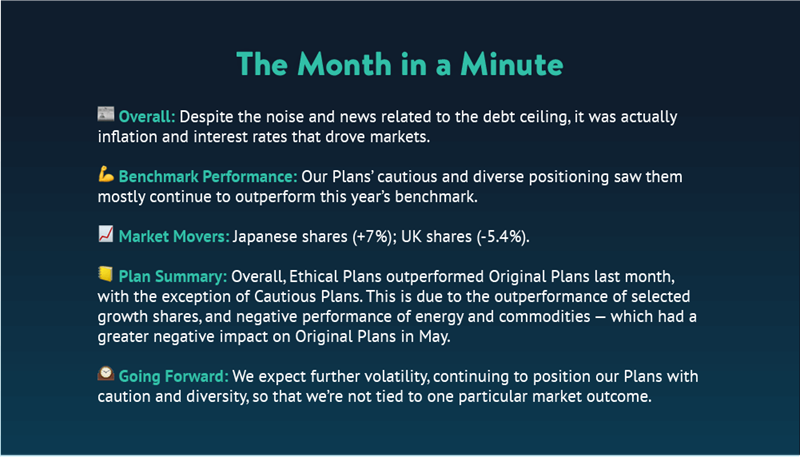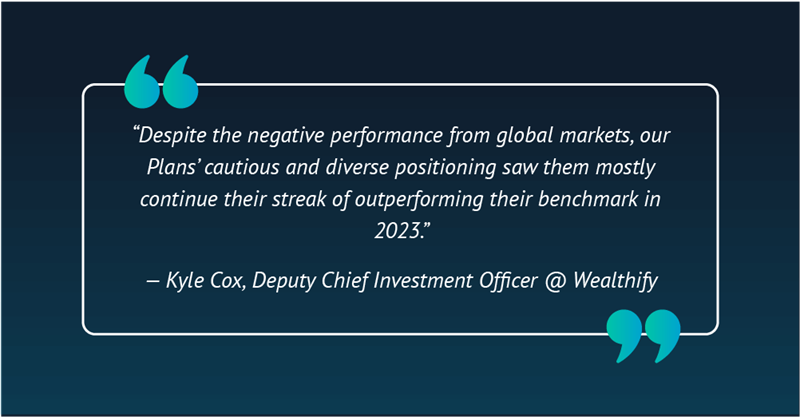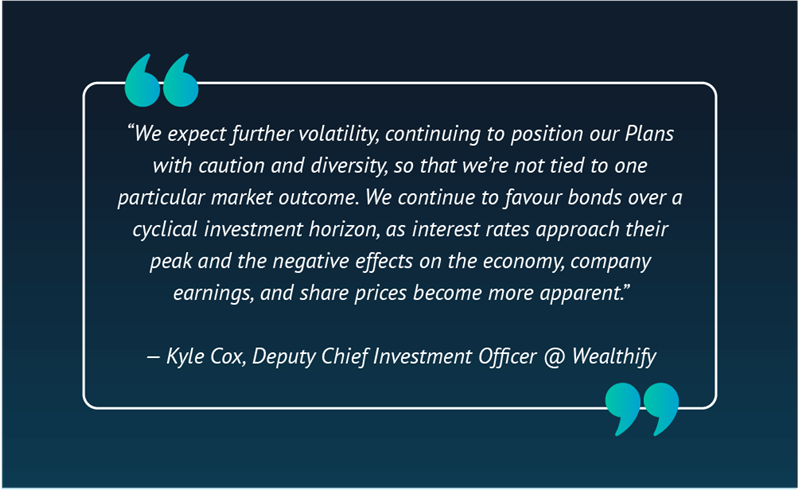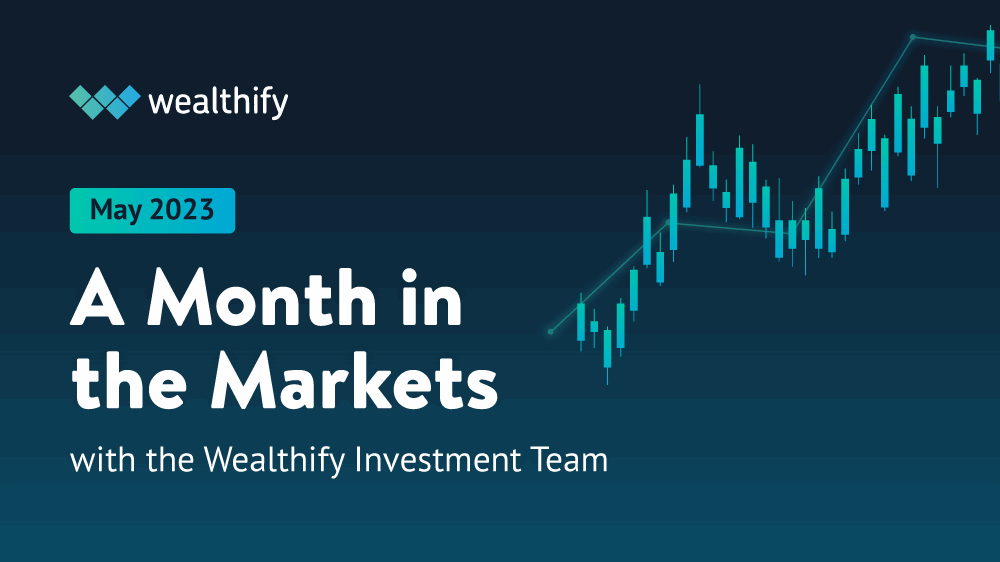
Global markets slumped in May, as the possibility of relief from the rising interest rates faded. Global bond and share prices bounced around in reaction to news related to US debt ceiling negotiations and further banking turmoil.
However, the greater driver (as has been the case throughout 2022 and 2023) of financial markets came from shifting expectations of what central banks will do next in their relentless pursuit to cool inflation with interest rate hikes.
Indeed, May’s economic data provided little backing for major central banks to pause – let alone cut – interest rates in 2023. Rising yields were mostly negative for regional share and bonds markets, with only a few exceptions.

The global economy continues to paint a mixed picture, as we see an ever-widening gap between activity in the manufacturing and services sectors.
In the US, Europe, and the UK, services have continued to expand, while manufacturing activity has continued to contract.
The widening services economy has been propelled by shifting consumer spending and robust savings levels, and has continued to buoy the labour market, with unemployment at – or near – historic lows. What’s more, demand for labour remains very strong in major developed economies.
In the US, inflation edged slightly down from the previous month (5.0%), settling at 4.9%. This still represents a sharp downtick from last year’s peak of 8.9% but remains still some way away from the target level of 2%. A slight resurgence in energy and used vehicle prices buoyed the inflation number in April, but it appears to be temporary given the downward trajectory in these items we’ve seen over the past six months.
The US jobs report [1] beat expectations yet again. This was a key driver of the shift in interest rate expectations, with investors concerned the Federal Reserve System (the Fed) will have to raise rates further to cool the jobs market to drive service or wage-driven inflation meaningfully down.
Economic activity appears to be growing healthily for now, propelled by a strongly expanding services economy — but moderated by a contraction in manufacturing activity.
Continued robustness in May’s economy dampened any expectations of interest rate cuts in 2023, casting a doubt over whether the Fed is set to pause on further hikes at its upcoming meetings. In Europe, an upturn in energy prices saw headline inflation rise from 6.9% to 7.0%. Core inflation – which excludes energy – fell slightly from 5.7% to 5.6%. Economic conditions have deteriorated somewhat as expected, with lower consumer confidence driving lower demand for physical goods.
Similar to the US, however, services activity continues to buoy consumer activity. A moderation in selected economic data cleared the path for the European Central Bank (ECB) to downshift its pace of hikes from 0.50%, as it raised interest rates by the expected 0.25% in May. There is, however, still more to come, with two more hikes expected.
Closer to home, UK inflation data continued to moderate from 10.1% to 8.7%. The market reacted negatively to the inflation print, as it came in well ahead of the expected 8.2%. What caught the eye of the market, too, was the greater-than-expected rise in both core and services inflation, which tend to be more persistent drivers of inflation.
Essentially, this led to a sharp upward readjustments of interest rate expectations needed to cool inflation, which had ripple effects across the UK market. A key driver of the more persistent inflation components is the labour market, which showed some softening, as the number of employees on payrolls fell by 136,000 in April (the market had expected an addition of 25,000). This will be welcomed by the Bank of England, as evidence that the tightening of financial conditions is beginning to cool the labour market.
Markets
In May, global shares and bonds delivered a modest loss of -1.3% and -2.0%, respectively. Developed market shares (-1.2%) outperformed emerging market shares (-1.9%). The main driver of this underperformance was the performance of Chinese shares, which pulled back due to weak global manufacturing data and a stumbling domestic economic recovery.
Developed markets were buoyed by a very narrow set of large US tech stocks, which outperformed the wider market due to strong earnings and increased positivity around the potential of Artificial Intelligence (AI). This saw the US S&P 500 index post a gain of 0.2% in May. Beyond this, the only notable share market to deliver positive returns was Japan (+7.0%), as investors became increasingly confident that the economy would transition away from unhealthy deflation to a healthy demand driven inflation economic environment.
Closer to home, market movements were less positive, unfortunately. After a positive run, European shares (-3.2%) gave back some of their returns, as the economic backdrop began to take its toll. UK shares also ended the month materially weaker, as rising interest rate expectations and lower commodity prices weighed on valuations. The larger FTSE 100 ended the month down -5.4%, while the smaller FTSE 250 ended the month down -3.6%.
Currency
Shifting interest rate differentials and falling risk appetite drove currency changes in May. The US dollar gained in value against most major currencies, as investors saw the possibility of interest rate cuts in the US as increasingly unlikely. Despite a sharp rise in UK interest rates, sterling was unable to avoid this trend, depreciating by 1% against the US dollar in May. Sterling did, however, show decent appreciation against other major currencies in May, gaining 2.0% in value and 1.2% against the euro and Japanese yen, respectively.
Investment type performance breakdown
In our Original Plans, shares (+0.2%) delivered slightly positive returns, as decent returns from our US and Japanese exposure were weighed down by UK and European exposure. Bonds (-1.0%) delivered negative returns, mainly due to rising bond yields in the UK.
Ethical shares (+2.1%) outperformed Original due to their bias towards growth sectors, which benefitted from optimism around the potential for AI. Ethical bonds (-1.4%) underperformed slightly relative to Original.
Overall, Ethical Plans outperformed Original Plans last month, with the exception of Cautious Plans. This is due to the outperformance of selected growth shares, and negative performance of energy and commodities — which had a greater negative impact on Original Plans in May.
Summary with Plan details
In May, Plans with a higher allocation to shares performed better than those with a higher allocation to lower-risk assets.

Our Investment Team continues to actively monitor the financial markets and their impact on your Plan — and are always ready to act in your best interests to events as they unfold. We are continually evaluating new market information and key market drivers to help keep your Investment Plan on track.
It’s important to remember that it’s normal for markets to go up and down, with periods of volatility to be expected when you invest.
As always, we continue to look for opportunities to position your investments, with the goal of protecting your money and achieving your long-term objectives.
Wealthify does not provide financial advice. Please seek financial advice if you are unsure about investing.
Please remember the value of your investments can go down as well as up, and you could get back less than invested. Past performance is not a reliable indicator of future results.



